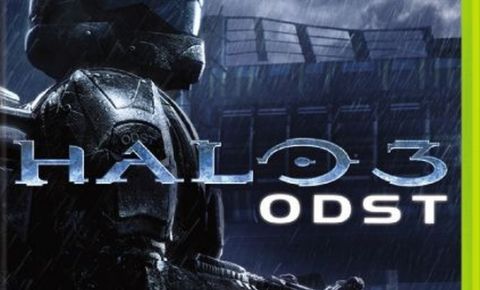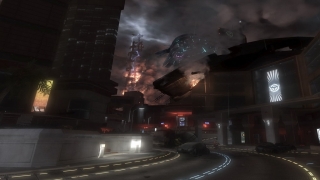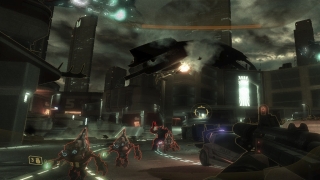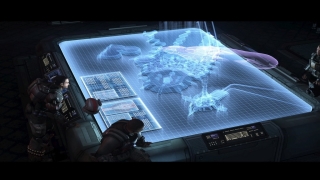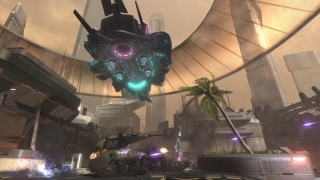Think of Halo 3: ODST as a centaur. Or as a gryphon. Or as a mermaid. Or as any other creature that is half an entity and half another. In the case of Halo 3: ODST, it is clearly half Master Chief and half human. Half classic firefights, pitched battles that never let you hold your breath and get the adrenalin pumping, and half quietly sneaking through a dark city, almost afraid to shoot the enemies. Half complex story delivered in interesting ways and half military stereotypes acted out in a flat manner. Half attempt at innovation from Bungie and half need for commercial success on the part of Microsoft. Half exciting experience and half disappointment. Think of Halo 3: ODST as being a game too ambitious to be an add on and too shy to be a full-fledged installment in the franchise.
Make no mistake, after getting into the action, this is a game you can actually play continuously until it is done, finished, complete. Bungie doesn't make those kinds of mistakes that would render a fan put down the controller and say they’re done because of low quality. But after delivering better and better experiences over the years, the company needed to do something innovative. A quantitative improvement, like the one from Halo 2 to 3, would just not do, they needed to deliver something qualitative. Unfortunately, ODST is just a more contained, sometimes brilliant game, best when getting as much distance from the usual mechanics of the series as possible. Unfortunately, that distance is not there most of the time. Still a fun experience, just not one designed to breathe new life into the Halo universe.
GameplayIf you've played any of the Halo titles until now, then ODST is nothing new. Sure, the Shock Drop Troopers are not able to do all the things Master Chief so expertly does. They are weaker, meaning that you will learn to drop into cover quicker to conserve health but it's not a major change as there are enough health packs lying around. The jump is supposed to be less powerful but in single player that's not really a problem and co-operative matches are another matter entirely. The new weapons, like the suppressed SMG, seem to lack a bit of punch but are useful in combat. Cortana never utters a word and you need to use the VISR (worst abbreviation ever?) to look around, identify enemies and get access to an overall map. Other than that, the guy behind the helmet could just as well be Master Chief. If not specifically told, probably 80% of gamers would never notice the difference between the two protagonists.
The real innovation coming from Bungie in ODST is the city of New Mombasa. It's pretty big, industrial, futuristic and dark. Oh, and the only people you meet are military or Covenant, which makes it a perfect battlefield. The player can go in guns blazing and take out packs of enemies or can get behind them, sneaking in the less illuminated areas. The atmosphere is heavy and it could have led to a Halo game showing how a normal human took the war and how the tragedy of combat unfolded on Earth. This is the tone hinted at in the promo videos and it could have marked a significant departure from Master Chief and what Halo meant before.
Unfortunately, Bungie injects in the night walk some combat sequences tripped by the Rookie character you control finding pieces of gear that belonged to his comrades. These are more straight up classic Halo, with a lot of quick combat, more enemies, some vehicles to be controlled (always, always drive that Warthog) and bigger enemies to blow up. It's enjoyable but not new in any way and I feel that the developers could have delivered something much more interesting by using their resources to expand the Rookie experience rather than giving us reheated firefights. Story
You're an Orbital Drop Shock Trooper. You have three guys in your squad (all voiced by Firefly actors, could Bungie be preparing something in that universe?). You drop into New Mombasa and get split up. As the Rookie, you need to piece what has happened to your comrades and then complete the mission. When you find the objects left behind by your mates, you get to play certain sequences from their perspective. It's a pretty basic story for a shooter, with none of the save the whole Universe urgency that came in the titles featuring Master Chief. There's quite a nice side story featuring a young girl and a naughty Artificial Intelligence being told through audio logs but some of the pieces seem a bit too hard to find for the good of continuity.
Graphics and sounds
The Halo 3 graphics engine is three years old and it shows. It holds up reasonably well when you creep through the dark streets of New Mombasa while using the VISR to see where you are going and when the need to actually look around is not pressing. But during the well illuminated sections, the game is just adequate, with nothing jumping out from the screen at you. Sure, big things get blown up and the fireworks are attractive but they don't actually seem to be the next best thing, especially when compared to the crispiness of Gears of War 2 or the faux realism of Uncharted 2.
The sound and music sections fare much better under close scrutiny. The voices of the characters are well chosen with Nathan Fillion instantly recognizable to those who have watched Firefly and Tricia Helfer doing a nice role as the Intelligence officer with a secret. The explosions and the weapon fire sound solid, although the Covenant forces at times sound too amusing and not enough like a serious threat.
The soundtrack of the exploration sections, when the darkness of the city envelops the player and when encounters are few and a bit far between, is especially noteworthy mainly because they do not use the normal full powered orchestral themes that appear in games featuring space marines and alien killing. It's a mix of jazz, strings and subdued instruments that instill a sense of waiting, maybe in preparation for the full action sequences, of paranoia and a bit of desperation, which is to be expected from a Shock Trooper in the middle of an occupied city, alone and pretty much sure to die a grim death at some point. It adds to the atmosphere of Halo 3: ODST and I hope Bungie does a noir videogame after releasing Reach.
Multiplayer
Halo 3: ODST is great value for those who are interested in getting the definitive multiplayer experience for the series. The second disc in the game case holds all the maps that have been released for Halo 3 over time and a few new ones, allowing the owner to jump right online, provided they have a Gold Xbox Live account, and join other players in multiplayer matches. It's a convenient way of making sure you have all the maps and can get into any game.
The multiplayer co-operative addition is the Firefight mode, which is built around the idea of groups of players holding out against waves after waves of Covenant forces. The pool of lives for the ODST is shared, leading to nice mechanics where players need not only take care of themselves but also protect others to make sure they don't use up a life. There are Skulls that modify aspects of the experience and the idea of holding on as far as possible is nice but it has been done before and doesn't feel like the main selling point of Halo 3: ODST.
Conclusion
Acquire it for the multiplayer element or to get a bite of Halo lore and action before Reach comes around and (hopefully) wraps the series up and allows Bungie to develop something new and possibly as good and revolutionary as the first game in this series. Just make sure you do not set your aspirations for ODST too high. There's almost nothing here you have not seen before, with the possible exception of Sadie's Story and a couple of fresh combat tactics.
 14 DAY TRIAL //
14 DAY TRIAL // 